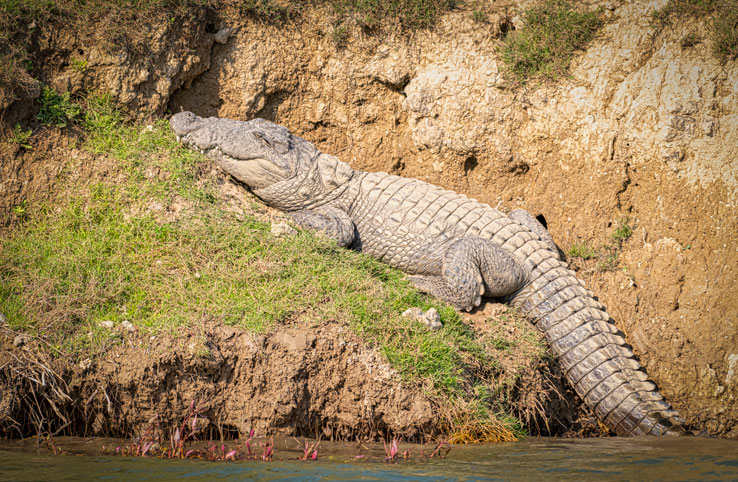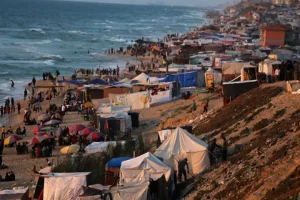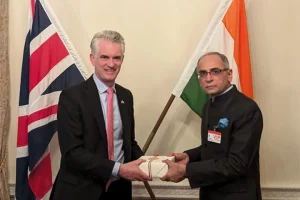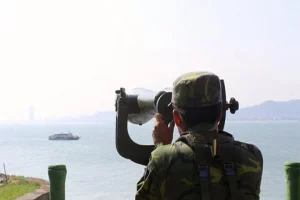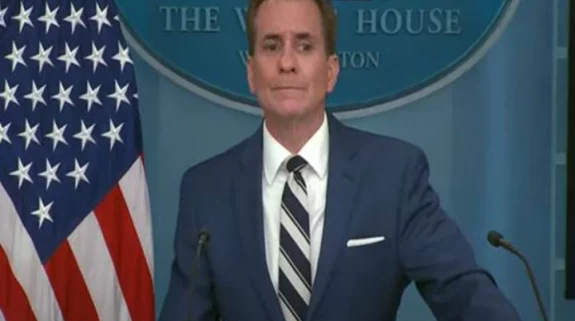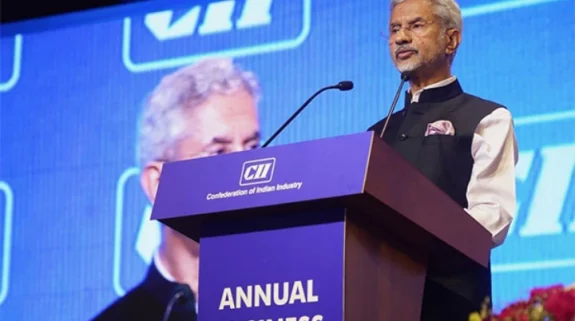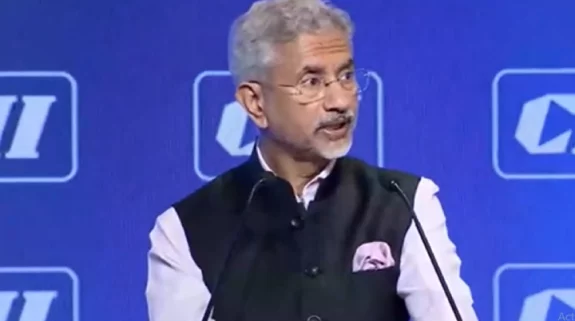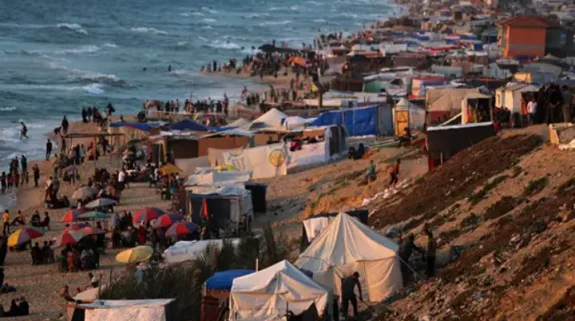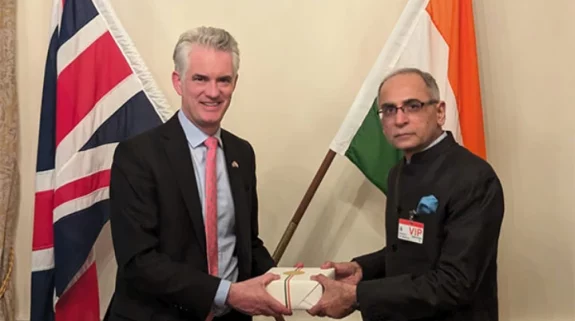“Chapak”… there was the sound of water splashing and we turned our heads in that direction, a huge Mugger crocodile jumped into the water. Probably he had seen us coming close. “Sir it’s a male, they are quite shy, they escape inside water even on slight disturbance” said our guide Dinesh.
“Did you get It? “I asked my companion Kamal Sahansi, a veteran wildlife photographer.
“I think so, what about you?” said Kamal. “Not sure, I was trying to focus my lens, suddenly it moved,” I said.

A Gharial in the Chambal river (Photo: Mrityunjoy Kumar Jha)
“Sir you will get many of them, Chambal is full of Muggers and Gharials,” said Dinesh, our guide at the Chambal Wildlife Sanctuary, about 70 kms from Taj Mahal. We were on a small motor boat and as we moved on, we saw two Mugger or Marsh Crocodiles. One was resting on the muddy bank, the other on sand.
I have seen documentaries on crocodiles of Africa and how they aggressively attack their prey who dare to venture into their territories. There’s something viscerally unsettling about these reptilian eyes and the obvious power. See a 10-15 feet long crocodile and it’s hard to think of yourself as anything more than lunch/dinner, when you are in the river. In India, Muggers or Marsh Crocodiles (Crocodyles Palustris) are vulnerable in the list of the IUCN.
The big male Marsh crocodile with a big broad-snouted mouth with a heavily “armoured” body, gave us a “don’t- mess-with-me” menace and fearsome look. We started clicking continuously, it was so close almost at our eye level. Suddenly it lifted its bulky belly on its feet and walk-cum crawled into the water. I kept looking in the water waiting for the Mugger to emerge under our boat. Thankfully it decided not to join us in our boat.

Indian crocodiles of the Chambal river say, 'let me live' (Photo: Mrityunjoy Kumar Jha)
Satisfied with this great photo session, we moved on looking for the main target – Gharial (Gavialis Gangeticus). They are a rare species of crocodiles which are Critically Endangered in the IUCN list. As is the case with so many special creatures, the Gharial population experienced heavy declines over the past several decades. In the river ecosystems of Pakistan, Myanmar, Bangladesh, and Bhutan, it is estimated that gharial populations declined from up to 10,000 in 1946 to fewer than 250 in 2006, which led them to be classified as critically endangered.
Conservation efforts began in the 1970s when the Indian government initiated a crocodile breeding and management project with the support of the UN and Food and Agriculture Organization. In1978, the National Chambal Sanctuary was established and the following year the first captive-bred gharials were released into the Chambal River, which cuts through ravines in Uttar Pradesh, Madhya Pradesh and Rajasthan. Over the years, close to 1400 gharials were released in the river through a captive-breeding programme. The number of gharials was 905 in 2012 and increased to 1,896 in 2019. On the other hand, the sanctuary had 205 mugger crocodiles in 2012 and their number rose to 706 in the past seven years.
Today, the Chambal river still holds the largest population of Gharials. Interestingly Gharials and Muggers both have been coexisting in the Chambal river. The success of the Chambal project was replicated in Nepal and three states of India – Uttar Pradesh, Odisha and Bihar.

A mugger proudly shows off his jaws (Photo: Mrityunjoy Kumar Jha)
The highlight of our cruise along the Chambal River was undoubtedly an encounter with the second largest crocodile in the world, the long-snouted Gharial, which is second only to the monstrous Saltwater Crocodile.
The boatman cut off the engine and slowly rowed towards them. There were 4-5 of them basking on the sand with a huge mugger in the background. Their heads were raised with long snouts shut. They had razor sharp teeth, upper set perfectly interlocked with the lower ones. Their olive colour glistened in the sun. Although their rows of pointy teeth look menacing, they are specialized for catching and holding onto fish, and pose little danger to people unlike the Mugger Crocs. The male, once he reaches maturity at about age 13, has a distinctive knob, or a pot, that begins to grow on the end of his snout.
One of them was tagged. The National Chambal Sanctuary, the forest departments and other agencies have been collecting eggs as part of the process. Once the eggs hatch at designated centres, the animals are released in the rivers.
Yesterday 40 Ghariyals were released in Ghaghra river. These Ghariyals were brought from Kukrail Ghariyal Center after Captive Breeding.@ChintanDobariy5 pic.twitter.com/mavpqPWlZJ
— Ankit Kumar, IFS (@AnkitKumar_IFS) December 7, 2020
Gharials are one of three crocodilians native to India, with the other two being the mugger and saltwater crocodiles. They are among the longest of crocodilians, with males measuring up to 6 metres or 20 feet in length and weighing up to 160 kg. As they are fish eaters, the gharials are characterised by their long, thin snouts and more than 100 sharp, interlocking teeth.
Holy shit! I thought those were floating sticks the Ghariyal was swimming through!!!
What an amazing pic! https://t.co/LVFM6qSYzd
— Shantanu (@shantanub) July 7, 2020
As we raced back, the setting Sun was turning Chambal’s still water orange and a juvenile gharial on the sand bar, was telling us, “Chambal is the last refuge for us Gharials. Please Mujhe Jeene Do, let me live.” Mujhe jeene Do was a 1963 Hindi film, the first film on dacoits shot in the ravines of Chambal.
Experts say that the wildlife of Chambal was much safer when real “dakus” used to rule over this region. No one used to dare to come here. But now sand mafias, poachers, illegal fishing, hunting and mining, industrial pollutions and climate change are posing dangers to the river, the Gharials and other species. It’s a wake-up call for all concerned states and agencies. “The Ganga and Yamuna are holy. But there’s a lot of pollution,” says our guide Dinesh, “The Chambal is unholy, but the water is healthy for these species.”
Also Read: Vulture conservation: India’s fight to save Lord Ram’s Jatau






